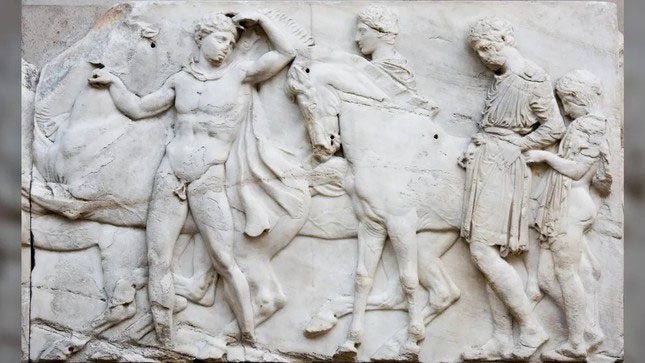Ancient Greek statues were long believed to be flawlessly white, but a new study reveals that the Parthenon sculptures were once vibrant with color.
The Parthenon sculptures, also known as the Elgin Marbles, were crafted by ancient Greeks around 2,500 years ago to adorn the exterior of the Parthenon temple in Athens. They are currently housed in the British Museum in London. Like many ancient sculptures, they feature a gentle blend of white, gray, and beige.

The Parthenon marble now appears white, but it was painted when first crafted in the 5th century BC. (Photo: markrhiggins via Getty Images).
Intricate Patterns, Vibrant Colors
However, a new study has revealed that the colors of these famous sculptures were not always dull— in fact, they were once adorned with intricate patterns and vibrant hues.
Bright blues, whites, and purples from ancient Egypt once covered the statues depicting gods and mythical creatures from the 5th century BC.
Researchers suggest that the colors were used to represent the water from which some characters emerged, the skin of a mysterious sea serpent, the empty space, and the air in the background behind the statues, as well as the decorative motifs on the cloaks of the gods.
The lead author of the study, Giovanni Verri, a conservation scientist at the Art Institute of Chicago, stated: “The Parthenon sculptures at the British Museum are considered one of the pinnacles of ancient art and have been studied by scholars for centuries. Nevertheless, no traces of color had been found, and very little information about how they were carved exists.”
Because paint typically does not last long on marble and the surfaces of the sculptures were not prepared to retain substances like paint, archaeologists have long believed that ancient Greek artists intentionally left the statues white.
To investigate the past of these statues, archaeologists used luminescence imaging, a technique that causes trace chemical elements from the hidden paint layers on the sculpture’s surface to glow. The research team quickly discovered hidden patterns on the surface of the statues, revealing blurred designs and symbolic images.
The researchers concluded that the statues were likely painted before being placed on the temple.


















































